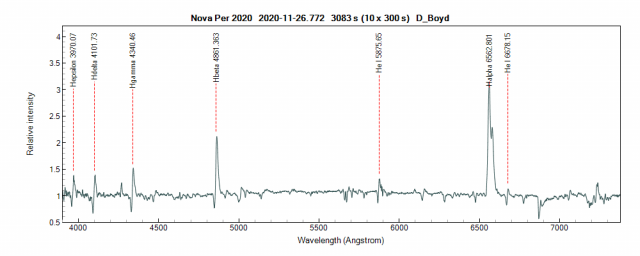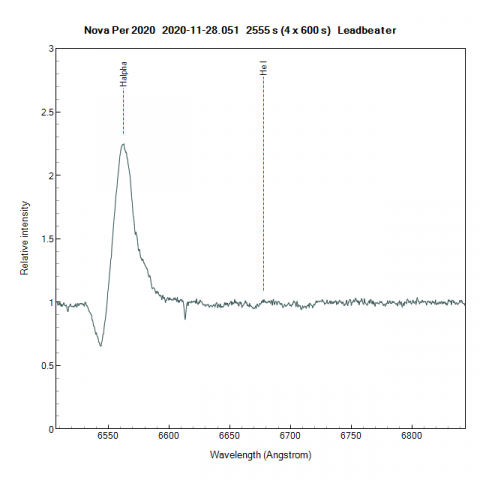› Forums › Variable Stars › Nova in Perseus
- This topic has 28 replies, 10 voices, and was last updated 3 years, 11 months ago by
 Jeremy Shears.
Jeremy Shears.
-
AuthorPosts
-
26 November 2020 at 10:57 am #574798
 Jeremy ShearsParticipant
Jeremy ShearsParticipantSeiji Ueda (Hokkaido, Japan) reports the discovery of a transient object in Perseus at mag 10.6 on Nov 25.807 (TCP J04291884+4354232). It appears to have a large outburst amplitude of 9.2 mag and might be a nova. UPDATE Nov 25 at 14.43: now confirmed as classical nova!!
There was an independent discovery by Stanislav Korotkij, Kirill Sokolovskij, and Olga Smolyankina, also at 10.6 on Nov 25.8438 (they refer to it as TCP J04291888+4354233)
20201123 <136c (Seiji Ueda)
20201123.57 <172g (ASAS-SN survey (Shappee+ 2014; Kochanek+ 2017))
20201125.37 171g (ASAS-SN survey (Shappee+ 2014; Kochanek+ 2017))
20201125.807 10.6c (Seiji Ueda; Canon EOS 6D digital camera + f/3.2 200-mm lens)
20201125.8438 10.6 (Stanislav Korotkij, Kirill Sokolovskij, and Ol’ga Smol’yankina; F=135mm f/2.0 telephoto lens and ST8300M unfiltered CCD)
20201125.913 10.2CV (Jeremy Shears, Cheshire; 28 cm SCT + Starlight Xpress H9 CCD)
20201125.938 10.4v (Gary Poyner, Birmingham; 22 cm refl)
20201126.115 10.22V (Katsumi Yoshimoto; 0.25-m f/3.4 reflector + CCD; remotely Mayhill, New Mexico)The position of the object (noted by Seiji Ueda ) is RA 04 29 18.84 Dec +43 54 23.2 (J2000.0)
Follow up photometry and spectroscopy is urgently required.
Jeremy Shears,
Director, VSS
26 November 2020 at 11:08 am #583391 Jeremy ShearsParticipant
Jeremy ShearsParticipantCharts and sequences of the transient are now available from the AAVSO website.
26 November 2020 at 1:34 pm #583392 Jeremy ShearsParticipant
Jeremy ShearsParticipantPosted image on my Members Page here.
26 November 2020 at 2:13 pm #583393 Robin LeadbeaterParticipant
Robin LeadbeaterParticipanthttp://www.astronomerstelegram.org/?read=14224
The confirming spectrum was taken with an ALPY600 and 10 inch telescope
(Here it was clear earlier last night but the arrival of the alert in my in box coincided with that of the clouds)
Robin
26 November 2020 at 2:45 pm #583394 Jeremy ShearsParticipant
Jeremy ShearsParticipantThanks for alerting about the ATel, Robin – pleased to see it’s now officially a classical nova.
26 November 2020 at 6:41 pm #583395 Nick JamesParticipant
Nick JamesParticipantMy image from just now (Nov 26.76) is on my members page here. It is just saturating in a 10s exposure but the unfiltered magnitude looks to be around 9.3.
26 November 2020 at 6:53 pm #583396 Jeremy ShearsParticipant
Jeremy ShearsParticipantYou need a smaller telescope, Nick! I was using 5 sec exposures on the C11.
Good target for visual observers even with relatively small instruments.
Super to have another northerly nova.
27 November 2020 at 9:51 am #583397 Mike HarlowSpectator
Mike HarlowSpectatorPoor conditions last night with thickening fog and a bright Moon but managed to get an image and (very) low resolution spectrum. Shows the main features of a nova in its early stages…bright continuum with hydrogen emission lines. Results on my members page.
Regarding photometry…you could try a small aperture mask on you main telescope to cut the brightness. I sometimes use a 4 inch or even 2 inch on my 12inch scope for spectroscopy of bright stars for example.
Mike.
27 November 2020 at 11:15 am #583399 Gary PoynerParticipant
Gary PoynerParticipantOne might even try looking at it 🙂 Mag 9.5 last night (Nov 26th) and looks to be brightening further, so binocular territory once the Moon is out of the way.
Gary
27 November 2020 at 11:50 am #583400 David BoydParticipant
David BoydParticipantThis is the first of two spectra I was able to record last night, 26th Nov. Thick fog eventually ended observations. The H Balmer and He I emission lines have prominent P Cygni dips on their blue edges caused by absorption in the material expanding towards us from the nova explosion.
David
 27 November 2020 at 2:23 pm #583402
27 November 2020 at 2:23 pm #583402 Mike HarlowSpectator
Mike HarlowSpectatorI guess most of you know this but spectra are now starting to be posted on the ARAS web page for this nova. Well worth checking regularly as the nova develops.
Mike.
27 November 2020 at 6:52 pm #583404 Nick JamesParticipant
Nick JamesParticipantGary. I assume you’re having to wear sunglasses when observing it?
27 November 2020 at 7:37 pm #583405 Lars LindhardParticipant
Lars LindhardParticipantThe nova is brightening, my estimate is mag 8.8 tonight
27 November 2020 at 7:56 pm #583406 Jeremy ShearsParticipant
Jeremy ShearsParticipantyes indeed. I had it at mag 8.9 at 18.30 this evening.
27 November 2020 at 8:58 pm #583407 David SwanParticipant
David SwanParticipantWhoa, that’s bright. Unfortunately it is (still) really cloudy here.
28 November 2020 at 2:25 pm #583411 Robin LeadbeaterParticipant
Robin LeadbeaterParticipantAn R~5500 LHIRES spectrum of Halpha/He I 6678 last night.

Lots of evolution over a day in spectra in BAA database
The interstellar line at 6613 is strong too. (I did a bit of Googling on that last night and it seems although it is thought to be molecular in origin, the species does not seem to be known. Does anyone know more about this )
28 November 2020 at 11:13 pm #583417 Tim HaymesParticipant
Tim HaymesParticipantA google search and a NASA paper “Taking apart the light” lists 661 nm as caused by Nitrogen. I dont know if this is a lab spectrum or “interstellar”. Will they be the same – or not i ask myself ? (Just a thought)
29 November 2020 at 11:51 am #583418 Jeremy ShearsParticipant
Jeremy ShearsParticipantThe nova now has an official variable star designation: V1112 Persei
29 November 2020 at 2:26 pm #583419 Gary PoynerParticipant
Gary PoynerParticipantNearly 🙂 Although with all this cloud, I’m just hoping I get to see it when at it’s brightest!
The AAVSO doesn’t yet recognise the new designation (V1112 Per), although I suspect it will very soon. There are some bright comparison stars on the 3 degree (180′) AAVSO chart that observers will need to use.
Gary
29 November 2020 at 2:55 pm #583421 Robin LeadbeaterParticipant
Robin LeadbeaterParticipantWhen I first saw it I expected it to be atomic in origin because it looks so narrow (Think NaD or K 7699 interstellar lines) but I found no matches. Apparently it is probably (I should say possibly, nothing seems very clear from the literature I have found) formed by a high molecular weight PAH molecule but exactly which one is not clear. It is fascinating that something that is seen in so many spectra and has been known about for many decades is still a mystery
Cheers
Robin
-
AuthorPosts
- You must be logged in to reply to this topic.
